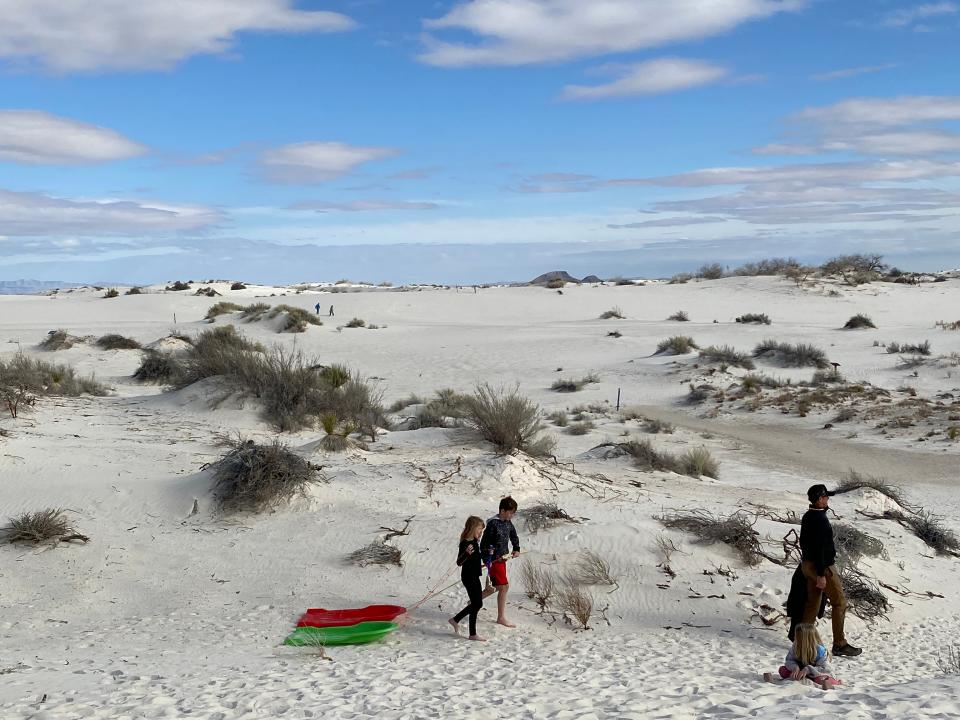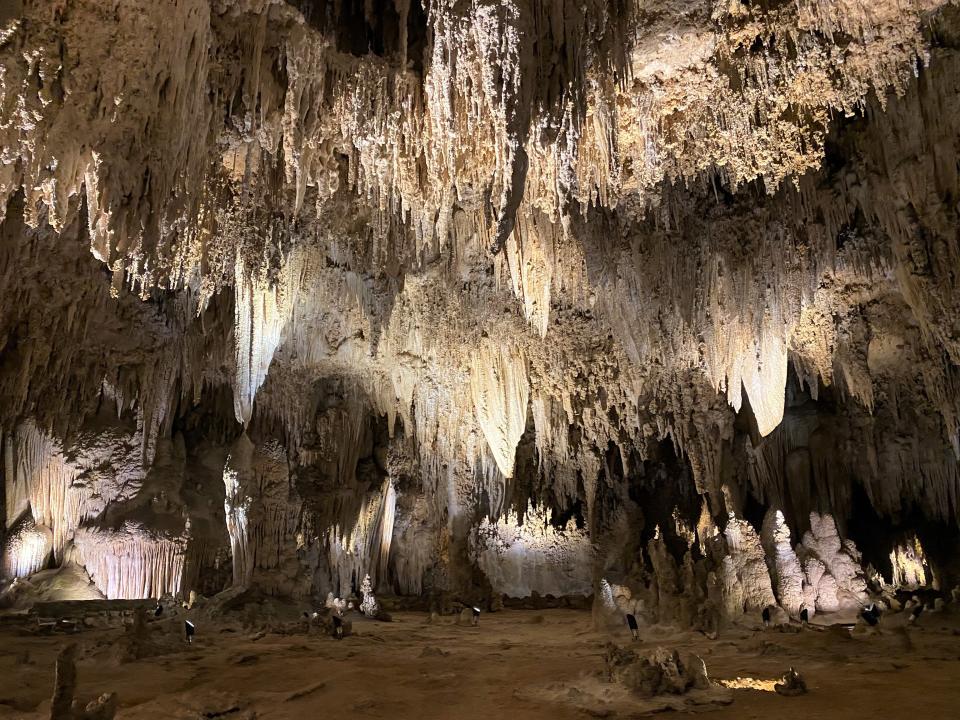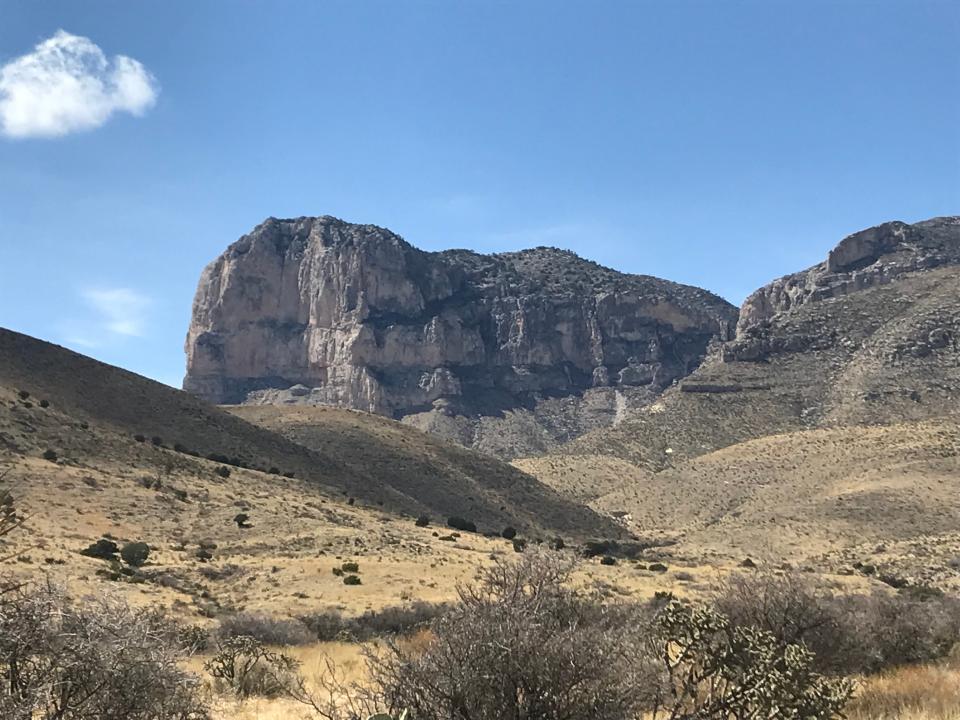Travel: Find serendipity amid beauty, quirky history while traveling in New Mexico
CARLSBAD, N.M. — Alligators. An astrochimp. Space aliens. A horse thief. Geronimo.
We stumbled upon many surprises while visiting southern New Mexico. Call it serendipity.
Beauty was the one constant. Candle-straight highways transported us across untamed deserts. Twisting, curving two-lanes lifted us into the Sacramento Mountains.
After landing at our gateway airport, El Paso, Texas, our stay in the city was brief. We allowed time to visit the historic downtown. Our first surprise was finding sculpted alligators in a fountain at San Jacinto Plaza. Real gators lived in the pond for 80 years and became part of El Paso’s cultural identity. The reptiles moved to the El Paso Zoo in 1965, and now the “Los Lagartos” sculpture by local artist Luis A. Jimenez Jr. honors their place in the city’s folklore.
The El Paso Museum of Art highlights the work of regional artists and serves as a cultural hub for West Texas, New Mexico and Northern Mexico. It attracts nearly 100,000 visitors a year. Nearby, the vibrant El Centro district has items for sale in open-air storefronts. The noisy streets stretch toward the Rio Grande, the river separating El Paso from Ciudad Juárez, Mexico.
A vast, empty region
We left behind the colorful commotion of El Paso and entered into near-nothingness when we crossed into New Mexico. This seemingly endless desert was reminiscent of a moon landscape. Here, rockets that shaped the early U.S. Space Program trace back to the White Sands Missile Range, a U.S. Army military testing area and firing range.

We “stood on the moon” at the New Mexico Museum of Space History in Alamogordo. The center highlights rocketry experiments that contributed to space exploration. A planetarium and the International Space Hall of Fame are part of the complex. Space junkies will appreciate the artifacts, such as an authentic moon rock, on display inside the museum, and in its outdoor exhibit area. By the flagpole, we paused at the gravesite of Ham, the chimpanzee launched into space in 1961. The astrochimp paved the way for Alan Shepard, the first American to travel into space.
We entered a surreal world of whiteness at White Sands National Park. Winds buffet the shimmering dunes that stretch to the horizon, a brilliance that is visible from the International Space Station. The national park’s nearly 148,000 acres protect a portion of the world’s largest gypsum dune field.
Travel to Texas: Discover the rugged beauty of Big Bend National Park’s mountains and desert
Many visitors carry snow saucers to the top of dunes for sledding adventures, and others hike the five established trails. The Alkali Flat Trail draws the most attention. With a length of more than four miles, including trudging up and down numerous dunes, it is rated as a moderately challenging route. The views of dunes and the shadows they cast stretching in all directions make the hike worth the effort. By contrast, the Interdune Boardwalk is less than one-half mile, all on an elevated, planked walkway from which creatures of the sand, such as lizards and snakes, are often spotted.
Into the mountains, into the snow
We ascended from the desert of the Tularosa Basin and drove into the Sacramento Mountains, expecting a day of hiking in the fragrant pinyon-juniper forests.
Instead, we encountered snowfall.
Cloudcroft, a village of about 800 people at an elevation of 8,650 feet, keeps an Old West vibe, with saloons and other businesses on Burro Avenue. We left for the resort village of Ruidoso by driving Route 244 through the mountains and ranchland of the Mescalero Apache Indian Reservation. The road winds through Elk Springs. To our astonishment, a herd of elk leaped over a roadside fence and disappeared into a stand of snow-laden trees.
Ruidoso lies in the Smokey Bear District of Lincoln National Forest. As the name suggests, the partially burned bear cub was rescued from a forest fire in 1950 in the adjacent Capitan Mountains. Smokey Bear became the symbol of wildfire prevention and wildlife conservation. Outlaw Billy the Kid (Henry McCarty) hid in these mountains. The gunslinging horse thief was killed at the age of 21, but lives on in movies and western lore.
Closer to home: Great Smoky Mountains National Park is a gem. Here's everything to know for your visit
The Sacramento Mountains dominated the scenery as we meandered through deep forest and passed horse farms and orchards. A sign at a fruit stand read “Self serve. Be honest.” As we proceeded into the Hondo Valley via U.S. Highway 70, we were once again in a desert landscape of cactus, yucca and rabbitbrush.
Extraterrestrial legacy
People from all over the world come to Roswell to experience the International UFO Museum and Research Center. The sensational attraction satisfies any visitor’s extraterrestrial hunger. Exhibits describe numerous alien sightings, including the famed “Roswell Incident” of 1947. A rancher found unusual debris scattered across his property. At first, the U.S. military claimed it had recovered parts of a flying disk at a crash site, but almost immediately retracted the statement.
Residents of Roswell embrace the space alien culture. Gift shops around the museum sell all manner of futuristic and bizarre space travel souvenirs. Advertisements and window displays incorporate UFO imagery. A Mexican restaurant depicts a space creature wearing a sombrero, and a barber shop shows very unearthly clientele. Even the McDonald’s restaurant caters to space aliens; silver extraterrestrial statues stand at its entrance.
Adventures run deep
We followed the Pecos River southward and arrived in Carlsbad, a city of nearly 32,000, founded in 1888. A 3.5-mile walking path along the shady riverbanks connects parks, picnic pavilions, beach areas and marinas. On a mountain above the city, the Living Desert Zoo and Gardens State Park combines a mile-plus walk through a botanical garden of Chihuahuan Desert plants, with visits to habitats featuring indigenous creatures like the javelina, buffalo, mountain lion and American bald eagle.
Carlsbad is the launching point to Carlsbad Caverns and Guadalupe Mountains national parks.

Carlsbad Caverns National Park is one of the nation’s most spectacular natural wonders. Visitors can walk into the cave through a natural entrance or descend 750 feet by elevator. We reached the Big Room, an 8.3-acre space with ceilings as high as 200 feet. Golden light illuminates massive stalactites, stalagmites, great curtains, soda straws and mushroom-shaped rocks. Rangers guide tours to the King’s Palace, the deepest chambers open to the public. Here, an eerie silence enveloped us as we gazed at formations dating back 500,000 years.
In the footsteps of Geronimo
Our journey continued to Guadalupe Mountains National Park in Texas, about 35 miles southwest of Carlsbad Caverns National Park. By pure happenstance, we found Geronimo.
These limestone mountains in the Chihuahuan Desert are the sacred home of the Apache people. The native hunters served as guides when Spanish explorers arrived in the mid-1500s. From the Spanish, the Apache men acquired horses and expanded their hunting range for hundreds of miles.
Relations with outsiders deteriorated over the centuries, leading to violent raids and reprisals. In 1849, the U.S. Army began a 30-year campaign to oust the Apache people. Tribal leaders and warriors, including the fearless Geronimo, fought fiercely into the 1880s to maintain a hold on their heartland.
The Mescalero Apache continue to live in parts of Texas, New Mexico and Mexico, and their cultural ties remain strong and meshed with Spanish influences. The massive pinnacle, El Capitan, was a landmark for the early Apache. Later, Spanish explorers visualized the image of the Virgin of Guadalupe on the face of the peak and regarded it as a pilgrimage site.
Guadalupe Mountains National Park holds the four highest peaks in Texas, including imposing Guadalupe Peak. At 8,751 feet, it is the highest natural point in Texas. The iconic El Capitan rises to 8,085 feet. Nearby, the Pine Springs Visitor Center offers several trailheads, including a short trail to the stone and timber remnants of the Pinery Station. The Butterfield Overland Mail operated Pinery Station beginning in 1858. Drivers used El Capitan as a geographical marker to reach Pinery Station.

To get an idea of life for settlers in this rugged country, we visited Frijole Ranch. Set near Manzanita Spring, the ranch house was built in 1876. Over the next decades, the house and additional outbuildings served as a cattle ranch, community center, school and post office. The one-half-mile Manzanita Spring Trail brought us to a small pond surrounded by grasses and Texas madrone trees.
Spring-fed streams also nourish the vegetation along the McKittrick Canyon Trail. The 6.8-mile, out-and- back trail courses through a narrow limestone canyon thick with deciduous trees, such as oaks, Texas walnut, bigtooth maple and velvet ash. This trail contrasts greatly to the desert trails where cholla, cactus, agave and sotol grow.
Linda Lange and Steve Ahillen are travel writers living in Knoxville, Tenn.
This article originally appeared on Knoxville News Sentinel: New Mexico has surreal sand dunes, snowy mountains, space alien lore

